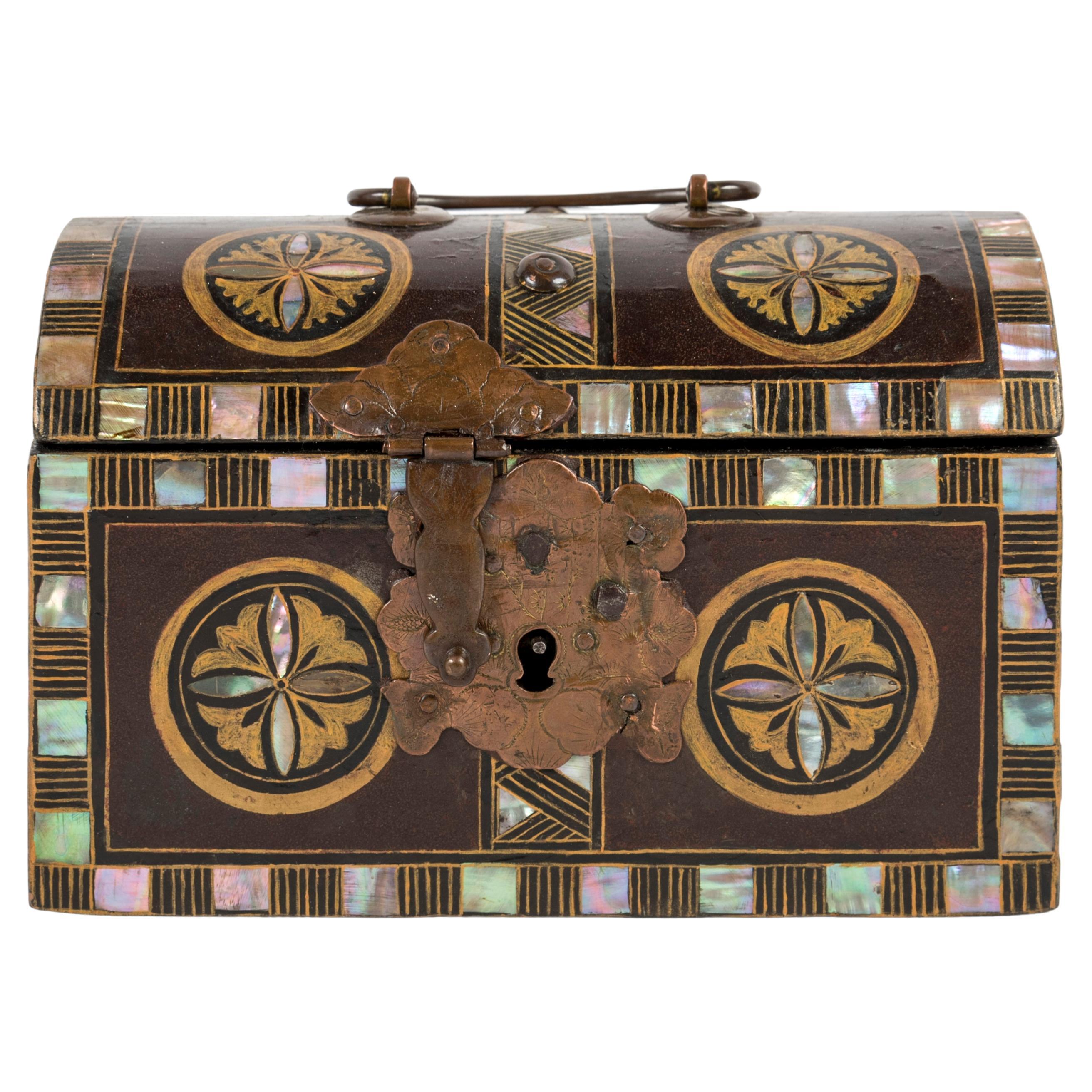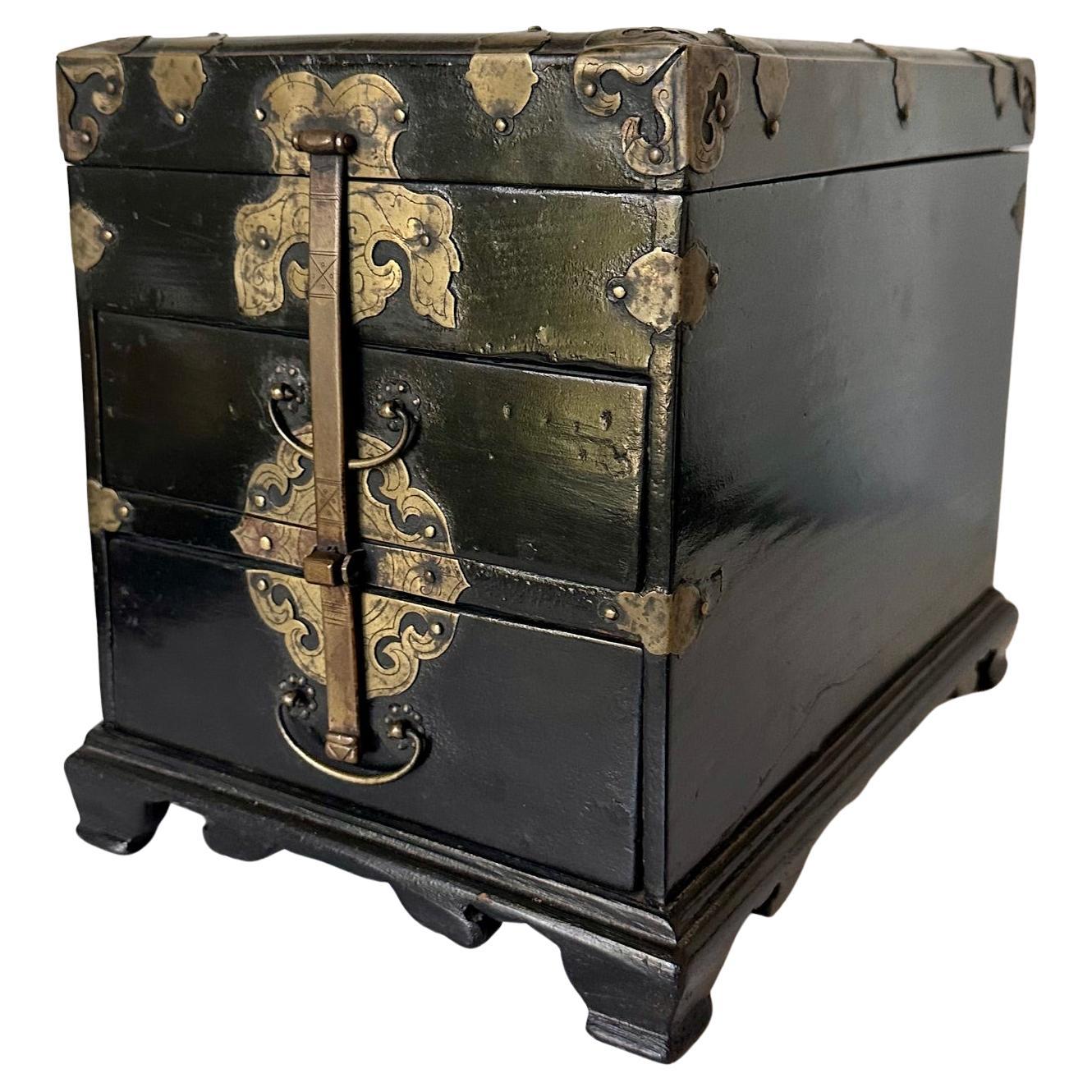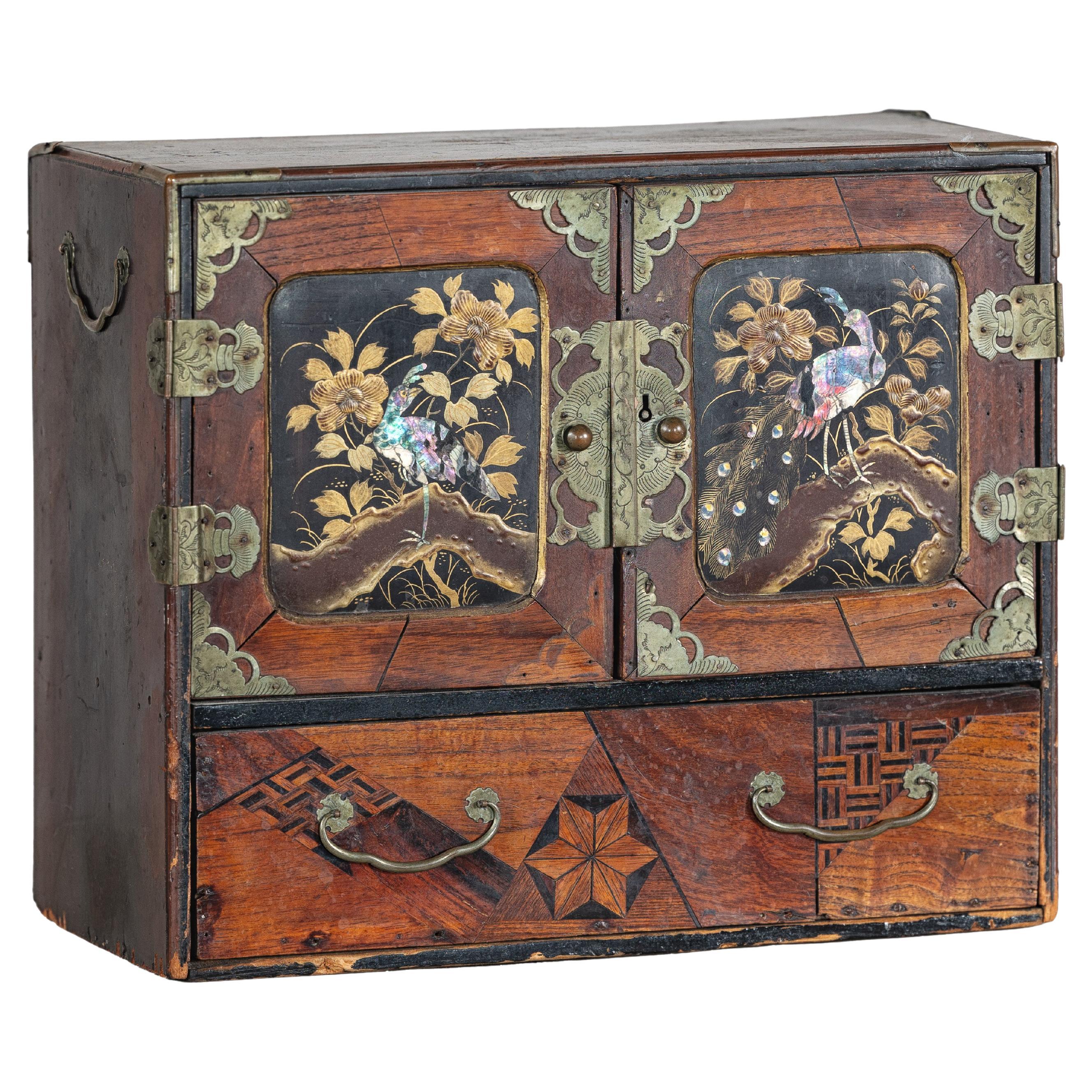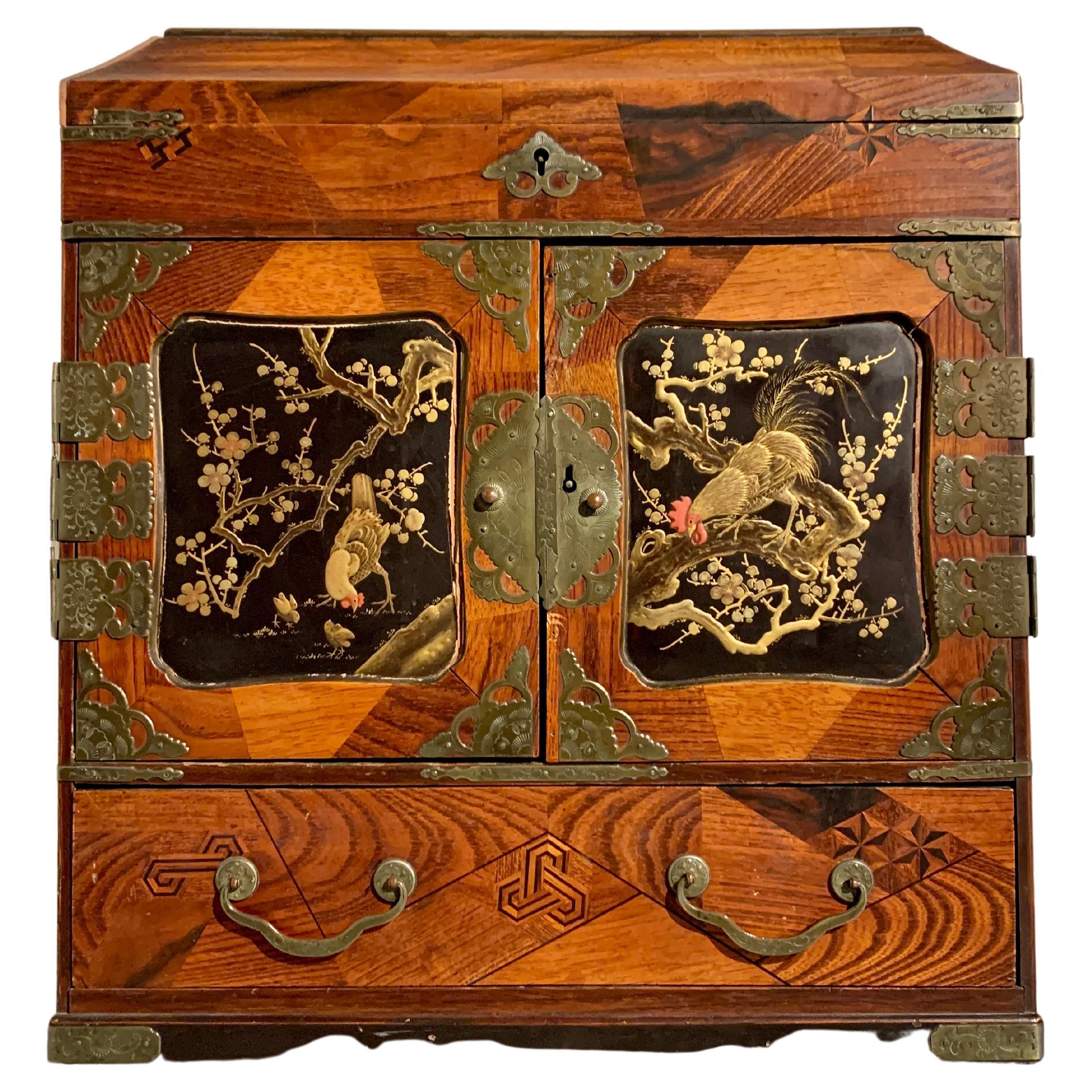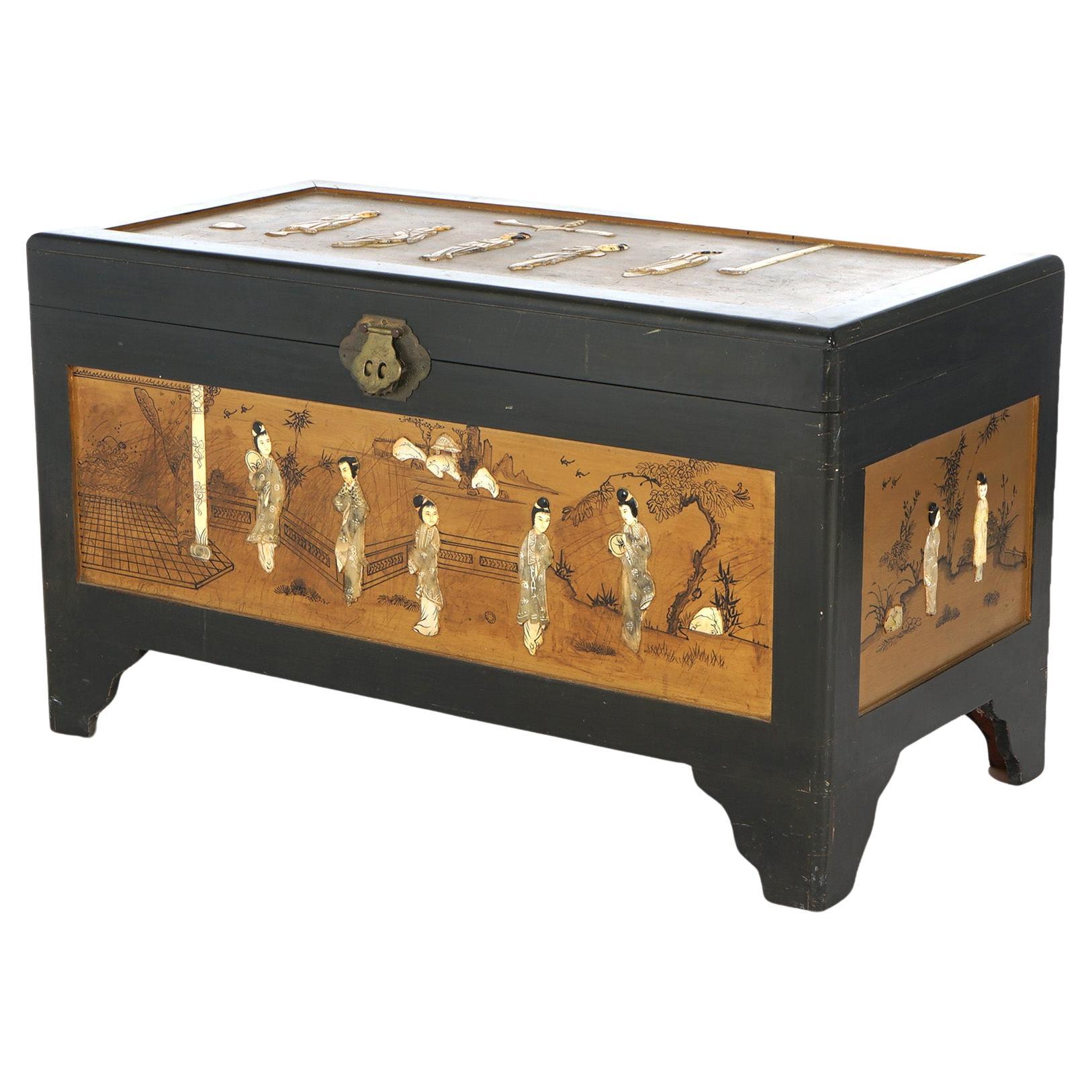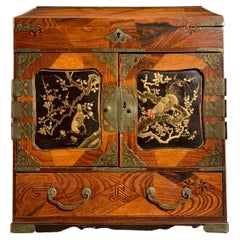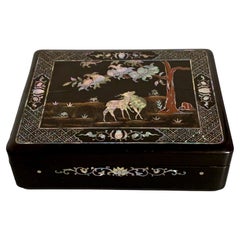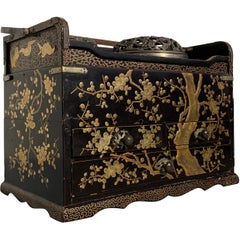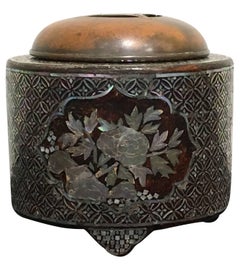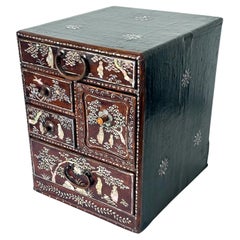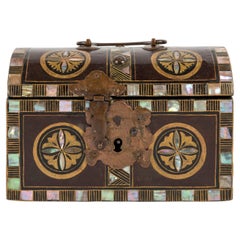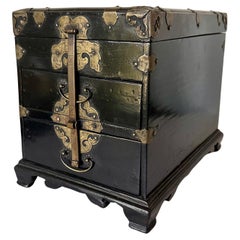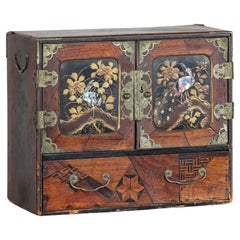Items Similar to Korean Lacquered Wood and Mother of Pearl Inlay Chest, Joseon Dynasty, 19th c
Want more images or videos?
Request additional images or videos from the seller
1 of 18
Korean Lacquered Wood and Mother of Pearl Inlay Chest, Joseon Dynasty, 19th c
$2,900
£2,201.63
€2,518.20
CA$4,051.72
A$4,506.40
CHF 2,353.10
MX$54,838.07
NOK 30,052.69
SEK 28,184.12
DKK 18,794.26
Shipping
Retrieving quote...The 1stDibs Promise:
Authenticity Guarantee,
Money-Back Guarantee,
24-Hour Cancellation
About the Item
A charming Korean keyaki (Japanese elm), lacquer, and mother-of-pearl inlaid personal accessory chest for a woman, Joseon Dynasty, early 19th century or earlier, Korea.
The small accessory chest crafted from precious keyaki wood, lacquered and inlaid with mother-of-pearl. The chest of near cube shape is raised on a square platform with bracket feet and features four deep drawers, the fronts of which are all inlaid with fine mother-of-pearl designs and mounted with brass pulls. The corners with further brass mounts.
The top drawer features two scenes. The left scene with a pair of mandarin ducks swimming amongst various aquatic plants. The right scene with a pair of long legged birds with long tails in a lush setting. One bird missing, the tail of their other bird partially missing. A single brass pull in the form of a bat.
The central two drawers feature a geometric diaper ground in a pattern often associated with hemp leaves. In this case, the central motif can also be interpreted as the Chinese character for rice. Each drawer with a brass pull in the shape of a peach.
The lower drawer with a pair of long tailed birds and large floral and foliate sprays. The single brass pull in the form of a bat.
This chest is full of symbolism. The wood used, keyaki, or Japanese elm, is considered a sacred tree in Korea, associated with protection. The pairs of birds are symbols of fidelity and marital happiness. Rice symbolizes prosperity, while the hemp leaf pattern offers protection. In Chinese, the word bat is a synonym for fortune, with the symbolism carrying over to Korea. The peach is a symbol of longevity.
Taken all together, this chest offers the owner wishes for protection, a long life, good fortune, and a happy marriage.
- Dimensions:Height: 11 in (27.94 cm)Width: 11 in (27.94 cm)Depth: 11 in (27.94 cm)
- Materials and Techniques:
- Place of Origin:
- Period:
- Date of Manufacture:early 19th century
- Condition:Wear consistent with age and use. Minor losses. Some gouges and scratches to the wood and lacquer. Missing some of the mother of pearl inlay. The mounts tarnished. Shrinkage to the drawers.
- Seller Location:Austin, TX
- Reference Number:1stDibs: LU894736045342
About the Seller
5.0
Platinum Seller
Premium sellers with a 4.7+ rating and 24-hour response times
Established in 2001
1stDibs seller since 2010
345 sales on 1stDibs
Typical response time: <1 hour
- ShippingRetrieving quote...Shipping from: Austin, TX
- Return Policy
Authenticity Guarantee
In the unlikely event there’s an issue with an item’s authenticity, contact us within 1 year for a full refund. DetailsMoney-Back Guarantee
If your item is not as described, is damaged in transit, or does not arrive, contact us within 7 days for a full refund. Details24-Hour Cancellation
You have a 24-hour grace period in which to reconsider your purchase, with no questions asked.Vetted Professional Sellers
Our world-class sellers must adhere to strict standards for service and quality, maintaining the integrity of our listings.Price-Match Guarantee
If you find that a seller listed the same item for a lower price elsewhere, we’ll match it.Trusted Global Delivery
Our best-in-class carrier network provides specialized shipping options worldwide, including custom delivery.More From This Seller
View AllJapanese Marquetry and Lacquer Jewelry Chest, Meiji Period, circa 1900, Japan
Located in Austin, TX
A very attractive Japanese wood table top jewelry or collector's chest with marquetry and lacquer decoration, Meiji period, circa 1900, Japan. Previously in the collection of Asbjorn Lunde (1927 - 2017).
The chest is crafted in the form of a Chinese seal...
Category
Antique Early 1900s Japanese Meiji Lacquer
Materials
Wood, Softwood, Lacquer
Korean Lacquer and Mother of Pearl Inlay "Longevity" Box, 1930s, Korea
Located in Austin, TX
A fine and elegant Korean black lacquer and abalone mother of pearl inlay "longevity" box, circa 1930s, Korea.
The box, most likely used to sto...
Category
Vintage 1930s Korean Showa Lacquer
Materials
Wood, Lacquer, Abalone
Japanese Lacquer Smoking Box, Tabako Bon, Edo Period, 19th Century
Located in Austin, TX
A very fine Japanese maki-e lacquer decorated tabako bon, or smoking box, late Edo Period, mid-19th century, Japan.
The elegant smoking box of black lacquer decorated with a wonderful gold lacquer takamaki-e design of a gnarled and elegantly twisted plum tree with branches in full bloom. A border of golden cranes in flight to the top.
The smoking box, called a tabako bon, is comprised of an open section at the top with inset with two cylindrical metal canisters...
Category
Antique Mid-19th Century Japanese Edo Lacquer
Materials
Lacquer
Japanese Edo Period Lacquer and Mother-of-Pearl Embellished Stoneware Koro
Located in Austin, TX
A highly unusual Japanese crackle glazed koro (incense burner or censer), lacquered and inlaid with mother-of-pearl embellishment, signed Gyokusen, Ed...
Category
Antique 19th Century Japanese Edo Scholar's Objects
Materials
Copper
Korean Lacquer and Mother of Pearl Inlay Stationery Box, c. 1930's, Korea
Located in Austin, TX
An elegant Korean black lacquer and mother of pearl inlay stationery box with lion and peony, circa 1930's, Korea.
The rectangular box and cover ...
Category
Vintage 1930s Decorative Boxes
Materials
Mother-of-Pearl, Softwood, Lacquer
Chinese Export Coromandel Lacquer Cabinet on Stand, Mid-19th Century, China
Located in Austin, TX
A delightful Chinese coromandel brown lacquer cabinet on stand, made for the export market, early to mid-19th century, China, presented on an early 20th century custom fitted stand.
The gem of a cabinet is fitted with doors and drawers, and decorated on all sides.
The top, back and sides with lacquer painted scenes of birds and flowers.
The front of the cabinet featuring a pair of stunning coromandel doors carved with a shanshui (mountain and water) landscape scene, complete with temples and pagodas, boats and bridges, and figures, all set against craggy mountains shrouded in clouds and rippling water.
The cabinet mounted with brass hinges and lock plates (key included) and a pair of carrying handles.
Opening the doors reveals eleven wondrous black lacquer drawers...
Category
Antique Mid-19th Century Chinese Chinese Export Furniture
Materials
Brass
You May Also Like
Antique Korean Mother of Pearl Inlay Lacquer Tabletop Accessory Chest Joseon
Located in Atlanta, GA
An antique Korean lacquered small chest of drawers with Mother-of-Pearl inlays circa 19th century (late Joseon Dynasty). The tabletop box with multiple small drawers of various sizes...
Category
Antique 19th Century Korean Other Lacquer
Materials
Brass
Japanese Namban Chest adorned with cylindrical motives and mother of pearl inlay
Located in PARIS, FR
Small namban style chest with a semi-cylindrical lid made of black lacquered wood (urushi) with gold lacquer (maki-e) and inlaid with mother-of-pearl (raden).
Mon style decoration (...
Category
Antique Mid-18th Century Japanese Lacquer
Materials
Lacquer, Mother-of-Pearl
Antique Korean Table Top Chest with Drawers Joseon Dynasty
Located in Atlanta, GA
A small tabletop storage cabinet made from Paulownia wood and lacquered in black and decorated with yellow brass hardware circa 1900s of late Joseon dynasty. With two drawers for sto...
Category
Antique Early 1900s Korean Other Furniture
Materials
Wood
Japanese Lacquer Box with Mother-of-Pearl Inlay and Parquetry Drawers
Located in Yonkers, NY
A finely crafted Japanese tabletop cabinet from the early 20th century, this compact storage piece is richly detailed with traditional decorative techniques and export-era flourishes...
Category
Early 20th Century Japanese Meiji Decorative Boxes
Materials
Wood
Antique Chinese Lacquered Ebonized & Gilt Blanket Chest with Mother of Pearl
Located in Big Flats, NY
***Reduced Delivery Rates - See Below or Click “Ask The Seller” to Request a Quote***
Antique Chinese Lacquered Ebonized & Gilt Blanket Chest with Mother of Pearl & Soapstone Inlaid...
Category
Early 20th Century Chinese Furniture
Materials
Wood
$960 Sale Price
20% Off
Antique Korean Joseon Dynasty Zelkova & Brass Bandaji Tansu Chest Trunk
Located in Dayton, OH
Antique Korean Bandaji chest or trunk featuring Zelkova elm frame with brass accents. The Korean name bandaji (literally meaning "half clo...
Category
Antique 19th Century Furniture
Materials
Brass
$3,500 Sale Price
40% Off
More Ways To Browse
Brass Inlay Wood
Wood Inlay Art
Pearl Inlay Furniture
Mother Of Pearl Inlay Furniture
Mother In Pearl Inlay
Brass Mother Of Pearls
Brass Tree Of Life
Korea Brass
Abalone Pearl
Chinese Lacquer Tree
Elm Tree
Antique Chinese Lacquer Chest
Marriage Chest
Lacquer Chest Japan
Wood Ducks
Antique Chinese Chest Of Drawers
Mother Of Pearl Chests
Abalone Inlay

